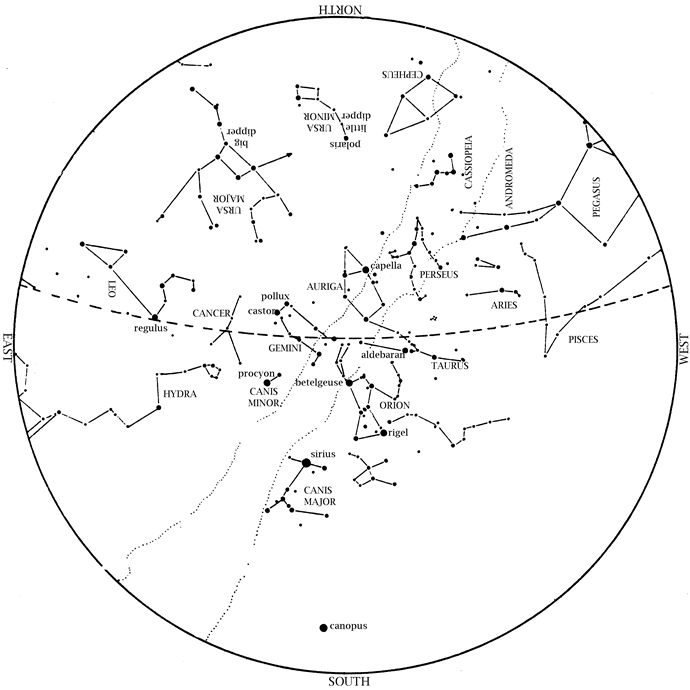Jupiter remains in the west southwest as night falls. However, Jupiter gets slightly lower each evening at sunset, until by mid-month it is getting lost in the Sun’s glare. Once it’s gone, we’ll have no evening planets until August.
Venus has entered the morning sky this month. Venus outshines everything except the Sun and the Moon, so you can try to find it low in the southeast at dawn. Venus remains a ‘morning star for most of 2022.
Mars is low the morning sky this month. Look low in the southeast at dawn, to the lower right of Venus.
Saturn is behind the Sun on February 4, and out of sight for us this month.
Taurus, the Bull is high in the south. Look for the Pleiades star cluster above reddish Aldebaran. Dazzling Orion, the Hunter takes center stage on winter evenings. Surrounding Orion are the brilliant stars of winter. Orion’s belt points down to Sirius, the Dog Star, which outshines all other stars we ever see at night. The Little Dog Star, Procyon, rises with Sirius and is level with Orion’s shoulder as they swing towards the south. To the upper left of Orion’s shoulder is Gemini, the Twins.
Under Sirius and low to the southern horizon this month is a star that most Americans never get to see—Canopus. Representing the bottom (keel) of the legendary ship Argo, Canopus is the second brightest star ever visible at night. Thus, it is clearly noticeable along the southern horizon on February and March evenings. However, you must be south of 37 degrees north to see Canopus rise. (This is the line that divides Utah, Colorado, and Kansas from Arizona, New Mexico, and Oklahoma.)

Taurus, the Bull, is almost overhead along with Gemini, the Twins. Dazzling Orion, the Hunter is high in the south, with his two dogs behind him. Sirius, the Big Dog Star, is the brightest star we ever see at night. Look for Canopus on the southern horizon below Sirius. Leo, the Lion, rises in the east. In the north, the Big Dipper has re-entered the evening sky.
Moon Phases in February 2022:
New January 31, 11:46 p.m. (February 1 in all time zones east of ours)
1st Quarter February 8, 7:50 a.m.
Full February 16, 10:56 a.m.
Last Quarter February 23, 4:32 p.m.
We have months due to people observing the lunar phase cycle, which lasts 29.5 days, and keeping time by that. Beginning in 45 BCE, Julius Caesar reformed the Roman calendar so that it kept pace with the seasons without adding a 13th month every few years. This involved lengthening most months to 30 or 31 days. February, though, was full of religious observances, so he left it at 28 days. Thus, February remains the only month shorter than the lunar cycle. In some years, then, one of the phases above can skip February altogether, as New Moon does for us in 2022.
Note that the specific time of the New Moon means that it falls on February 1 in all time zones east of ours. That’s why, for example, Chinese Lunar New Year is February 1 rather than January 31, 2022.
Our George Observatory is now open every Saturday night for observing! Purchase tickets in advance on our website.
Clear Skies!
Look back at the January 2022 Sky Happenings.







